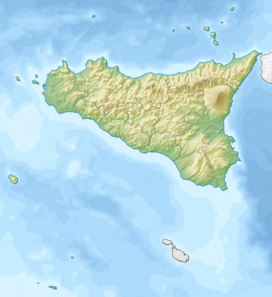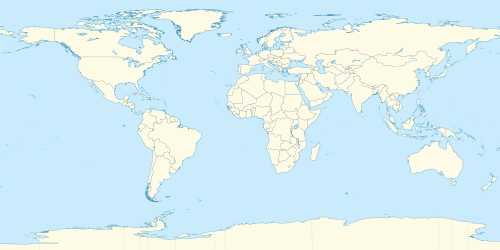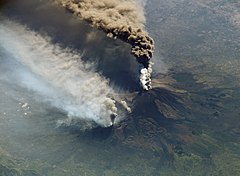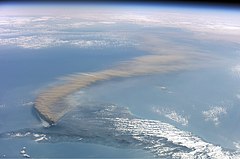Mount Etna: Difference between revisions
| [pending revision] | [pending revision] |
Only for official names. |
No edit summary |
||
| Line 36: | Line 36: | ||
| Link = http://whc.unesco.org/en/list/1427}} |
| Link = http://whc.unesco.org/en/list/1427}} |
||
}} |
}} |
||
'''Mount Etna''' ({{lang-it|'Etna'}}, {{lang-scn|{{noitalics|Mungibeddu or a Muntagna}}}} {{lang-la|{{noitalics|Aetna}}}}) is an active [[stratovolcano]] on the east coast of [[Sicily]], [[Italy]], in the [[Province of Catania]], between [[Messina, Italy|Messina]] and [[Catania]]. It lies above the convergent plate margin between the [[African Plate]] and the [[Eurasian Plate]]. It is the tallest active volcano on the [[Europe]]an continent, currently {{convert|3329|m|ft|0|abbr=on}} high, though this varies with summit eruptions. It is the highest mountain in Italy south of the [[Alps]]. Etna covers an area of {{convert|1190|km2|sqmi|0|abbr=on}} with a basal circumference of 140 km. This makes it by far the largest of the three [[Volcanism in Italy|active volcanoes in Italy]], being about two and a half times the height of the next largest, [[Mount Vesuvius]]. Only [[Mount Teide]] in [[Tenerife]] surpasses it in the whole of the European–North-African region.<ref>{{cite web|url=http://vulcan.wr.usgs.gov/Volcanoes/Italy/description_italy_volcanics.html|title=Italy volcanoes and Volcanics|publisher=USGS}}</ref> In Greek Mythology, the deadly monster [[Typhon]] was trapped under this mountain by [[Zeus]], the god of the sky and thunder and king of gods, and the forges of [[Hephaestus]] were said to also be located underneath it.<ref>[[Claudius Aelianus|Aelian]], ''Hist. An.'' xi. 3, referenced under [http://quod.lib.umich.edu/m/moa/acl3129.0001.001/69?page=root;size=100;view=image Aetnaeus] in William Smith's [[Dictionary of Greek and Roman Biography and Mythology]]</ref> |
'''Mount Etna''' ({{lang-it|'Etna'}}, {{lang-scn|{{noitalics|Mungibeddu or a Muntagna}}}}, {{lang-la|{{noitalics|Aetna}}}}) is an active [[stratovolcano]] on the east coast of [[Sicily]], [[Italy]], in the [[Province of Catania]], between [[Messina, Italy|Messina]] and [[Catania]]. It lies above the convergent plate margin between the [[African Plate]] and the [[Eurasian Plate]]. It is the tallest active volcano on the [[Europe]]an continent, currently {{convert|3329|m|ft|0|abbr=on}} high, though this varies with summit eruptions. It is the highest mountain in Italy south of the [[Alps]]. Etna covers an area of {{convert|1190|km2|sqmi|0|abbr=on}} with a basal circumference of 140 km. This makes it by far the largest of the three [[Volcanism in Italy|active volcanoes in Italy]], being about two and a half times the height of the next largest, [[Mount Vesuvius]]. Only [[Mount Teide]] in [[Tenerife]] surpasses it in the whole of the European–North-African region.<ref>{{cite web|url=http://vulcan.wr.usgs.gov/Volcanoes/Italy/description_italy_volcanics.html|title=Italy volcanoes and Volcanics|publisher=USGS}}</ref> In Greek Mythology, the deadly monster [[Typhon]] was trapped under this mountain by [[Zeus]], the god of the sky and thunder and king of gods, and the forges of [[Hephaestus]] were said to also be located underneath it.<ref>[[Claudius Aelianus|Aelian]], ''Hist. An.'' xi. 3, referenced under [http://quod.lib.umich.edu/m/moa/acl3129.0001.001/69?page=root;size=100;view=image Aetnaeus] in William Smith's [[Dictionary of Greek and Roman Biography and Mythology]]</ref> |
||
Mount Etna is one of the most active volcanoes in the world and is in an almost constant state of activity. The fertile volcanic soils support extensive [[agriculture]], with [[vineyard]]s and [[orchard]]s spread across the lower slopes of the mountain and the broad Plain of Catania to the south. Due to its history of recent activity and nearby population, Mount Etna has been designated a [[Decade Volcano]] by the [[United Nations]].<ref>{{cite web|url=http://vulcan.wr.usgs.gov/Volcanoes/DecadeVolcanoes/framework.html|title=Decade Volcanoes|publisher=[[United States Geological Survey]]}}</ref> In June 2013, it was added to the list of [[UNESCO World Heritage Sites]].<ref>{{citation |url=http://www.italymagazine.com/news/mount-etna-becomes-world-heritage-site| title=Mount Etna Becomes a World Heritage Site |publisher=Italy Magazine |date=4 May 2013}}</ref> |
Mount Etna is one of the most active volcanoes in the world and is in an almost constant state of activity. The fertile volcanic soils support extensive [[agriculture]], with [[vineyard]]s and [[orchard]]s spread across the lower slopes of the mountain and the broad Plain of Catania to the south. Due to its history of recent activity and nearby population, Mount Etna has been designated a [[Decade Volcano]] by the [[United Nations]].<ref>{{cite web|url=http://vulcan.wr.usgs.gov/Volcanoes/DecadeVolcanoes/framework.html|title=Decade Volcanoes|publisher=[[United States Geological Survey]]}}</ref> In June 2013, it was added to the list of [[UNESCO World Heritage Sites]].<ref>{{citation |url=http://www.italymagazine.com/news/mount-etna-becomes-world-heritage-site| title=Mount Etna Becomes a World Heritage Site |publisher=Italy Magazine |date=4 May 2013}}</ref> |
||
Revision as of 12:05, 19 August 2014
| Mount Etna | |
|---|---|
 Etna with the city of Catania in the foreground | |
| Highest point | |
| Elevation | 3,350 m (10,990 ft), (varies)[1] |
| Prominence | 3,329.6 m (10,924 ft) Ranked 59th |
| Isolation | 998.79 km (620.62 mi) |
| Listing | Ultra |
| Geography | |
| Region | IT |
| Geology | |
| Rock age | 350,000 - 500,000 years |
| Mountain type | Stratovolcano (composite type) |
| Last eruption | 2013 to 2014 (ongoing) |
| Climbing | |
| Easiest route | mountain bike |
| Criteria | Natural: vii, viii, ix |
| Reference | 1427 |
| Inscription | 2013 (37th Session) |
Mount Etna (Template:Lang-it, Template:Lang-scn, Template:Lang-la) is an active stratovolcano on the east coast of Sicily, Italy, in the Province of Catania, between Messina and Catania. It lies above the convergent plate margin between the African Plate and the Eurasian Plate. It is the tallest active volcano on the European continent, currently 3,329 m (10,922 ft) high, though this varies with summit eruptions. It is the highest mountain in Italy south of the Alps. Etna covers an area of 1,190 km2 (459 sq mi) with a basal circumference of 140 km. This makes it by far the largest of the three active volcanoes in Italy, being about two and a half times the height of the next largest, Mount Vesuvius. Only Mount Teide in Tenerife surpasses it in the whole of the European–North-African region.[2] In Greek Mythology, the deadly monster Typhon was trapped under this mountain by Zeus, the god of the sky and thunder and king of gods, and the forges of Hephaestus were said to also be located underneath it.[3]
Mount Etna is one of the most active volcanoes in the world and is in an almost constant state of activity. The fertile volcanic soils support extensive agriculture, with vineyards and orchards spread across the lower slopes of the mountain and the broad Plain of Catania to the south. Due to its history of recent activity and nearby population, Mount Etna has been designated a Decade Volcano by the United Nations.[4] In June 2013, it was added to the list of UNESCO World Heritage Sites.[5]
Etymology
According to Adrian Room’s book Place-names of the World, the name Etna originated from the Phoenician word attuna meaning "furnace" or "chimney". He dismisses the hypothesis that Etna is from the Greek αἴθω (aithō) - meaning "I burn" - through an iotacist pronunciation.[6] In Classical Greek, it is called Αἴτνη (Aítnē),[7] a name given also to Catania and the city originally known as Inessa, and in Latin it is called Aetna. In Arabic, it was called جبل النار Jabal al-Nār (the Mountain of Fire).[8]
It is also known as Mungibeddu in Sicilian and Mongibello or Montebello in Italian (from the Latin mons and the Arabic جبل jabal, both meaning mountain, producing a tautological place name, "mountain mountain").[9] The term is not in common use today, although some older people still call it this. According to another hypothesis the term Mongibello comes from the Latin Mulciber (qui ignem mulcet, who placates the fire), one of the Latin names of the god Vulcan.
The people of the Etna sometimes use the jargon term 'a muntagna, simply "the mountain" par excellence.
Nowadays, the term Mongibello indicates the mountain's top area of the two central craters encompassing also the craters in the southeast and the northeast of the volcanic cone.
History of volcanic eruptions
Geological history

Volcanic activity first took place at Etna about half a million years ago, with eruptions occurring beneath the sea off the ancient coastline of Sicily.[10] About 300,000 years ago, volcanism began occurring to the southwest of the summit (center top of volcano) then, before activity moved towards the present centre 170,000 years ago. Eruptions at this time built up the first major volcanic edifice, forming a stratovolcano in alternating explosive and effusive eruptions. The growth of the mountain was occasionally interrupted by major eruptions, leading to the collapse of the summit to form calderas.
From about 35,000 to 15,000 years ago, Etna experienced some highly explosive eruptions, generating large pyroclastic flows, which left extensive ignimbrite deposits. Ash from these eruptions has been found as far away as south of Rome's border, 800 km (497 mi) to the north.
Thousands of years ago, the eastern flank of the mountain experienced a catastrophic collapse, generating an enormous landslide in an event similar to that seen in the 1980 eruption of Mount St. Helens. The landslide left a large depression in the side of the volcano, known as 'Valle del Bove' (Valley of the Ox). Research published in 2006 suggested this occurred around 8000 years ago, and caused a huge tsunami, which left its mark in several places in the eastern Mediterranean. It may have been the reason the settlement of Atlit Yam (Israel), now below sea level, was suddenly abandoned around that time.[11]
The steep walls of the valley have suffered subsequent collapses on numerous occasions. The strata exposed in the valley walls provide an important and easily accessible record of Etna's eruptive history.
The most recent collapse event at the summit of Etna is thought to have occurred about 2,000 years ago, forming what is known as the Piano Caldera. This caldera has been almost entirely filled by subsequent lava eruptions, but is still visible as a distinct break in the slope of the mountain near the base of the present-day summit cone.
Eruptions
Historical eruptions
Eruptions of Etna follow a variety of patterns. Most occur at the summit, where there are currently (as of 2008)[update] five distinct craters—the Northeast Crater, the Voragine, the Bocca Nuova, and the Southeast Crater Complex (2). Other eruptions occur on the flanks, which have more than 300 vents ranging in size from small holes in the ground to large craters hundreds of metres across. Summit eruptions can be highly explosive and spectacular, but rarely threaten the inhabited areas around the volcano. In contrast, flank eruptions can occur down to a few hundred metres altitude, close to or even well within the inhabited areas. Numerous villages and small towns lie around or on cones of past flank eruptions. Since the year AD 1600, at least 60 flank eruptions and countless summit eruptions have occurred; nearly half of these have happened since the start of the 20th century, and since 2000, Etna has had four flank eruptions—in 2001, 2002–2003, 2004–2005, and 2008-2009. Summit eruptions occurred in 2006, 2007–2008, January–April 2012, and again in July–October 2012.
The first known record of eruption at Etna is that of Diodorus Siculus.[12]
The Roman poet Virgil gave what was probably a first-hand description of an eruption in the Aeneid:[13]

|
|
In 396 BC, an eruption of Etna reportedly thwarted the Carthaginians in their attempt to advance on Syracuse during the Second Sicilian War.
A particularly violent explosive (Plinian) summit eruption occurred in 122 BC, and caused heavy tephra falls to the southeast, including the town of Catania, where many roofs collapsed.[14] To help with reconstruction after the devastating effects of the eruption, the Roman government exempted the population of Catania from paying taxes for ten years.
During the first 1500 years AD, many eruptions have gone unreported (or records have been lost); among the more significant are: (1) an eruption in about 1030 AD near Monte Ilice on the lower southeast flank, which produced a lava flow that travelled about 10 km, reaching the sea north of Acireale; the villages of Santa Tecla and Stazzo are built on the broad delta built by this lava flow into the sea; (2) an eruption in about 1160 (or 1224), from a fissure at only 350–450 m (1,148–1,476 ft) elevation on the south-southeast flank near the village of Mascalucia, whose lava flow reached the sea just to the north of Catania, in the area now occupied by the portion of the city named Ognina.[citation needed]
Etna's most destructive eruption since 122 BC started on 11 March 1669 and produced lava flows that destroyed at least 10 villages on its southern flank before reaching the city walls of the town of Catania five weeks later, on 15 April. The lava was largely diverted by these walls into the sea to the south of the city, filling the harbour of Catania. A small portion of lava eventually broke through a fragile section of the city walls on the western side of Catania and destroyed a few buildings before stopping in the rear of the Benedictine monastery, without reaching the centre of the town. Contrary to widespread reports of up to 15,000 (or even 20,000) human fatalities caused by the lava,[15] contemporaneous accounts written both in Italian and English mention no deaths related to the 1669 eruption (but give very precise figures of the number of buildings destroyed, the area of cultivated land lost, and the economic damage), so it can be safely assumed that the enormous number of fatalities often picked up also by the news media must be a confusion with the earthquake that devastated southeast Sicily (including Catania) 24 years later, in 1693. A study on the damage and fatalities caused by eruptions of Etna in historical times reveals that only 77 human deaths are attributable with certainty to eruptions of Etna, most recently in 1987 when two tourists were killed by a sudden explosion near the summit.[16]
Recent eruptions
Large lava flow from an eruption in 1928 led to the first (and only) destruction of a population centre since the 1669 eruption. The eruption firstly started high on Etna's northeast flank on November 2. Then new eruptive fissures opened at ever lower elevation down the flank of the volcano. The third and most vigorous of these fissures opened late on 4 November at an unusually low elevation, approximately 1,200 m (3,937 ft) above sea-level, in a zone known as Ripe della Naca. The village of Mascali, lying down-slope of the Ripe della Naca, suffered obliteration in just two days, with the lava destroying nearly every building. Only a church and a few surrounding buildings survived in the north part of the village, called Sant'Antonino or "il quartiere". During the last days of the eruption, the flow interrupted the Messina-Catania railway line and destroyed the train station of Mascali. The event was used by Benito Mussolini's Fascist regime for propaganda purposes, with the evacuation, aid, and rebuilding operations being presented as models of fascist planning. Mascali was rebuilt on a new site, and its church contains the Italian fascist symbol of the torch, placed above the statue of Jesus Christ. In early November 2008, the town of Mascali commemorated the 80th anniversary of the eruption and destruction of the village with a number of public events where eyewitnesses shared their memories of the eruption.[citation needed]
Other major 20th-century eruptions occurred in 1949, 1971, 1981, 1983 and 1991–1993. In 1971, lava buried the Etna Observatory (built in the late 19th century), destroyed the first generation of the Etna cable-car, and seriously threatened several small villages on Etna's east flank. In March 1981, the town of Randazzo on the northwestern flank of Etna narrowly escaped destruction by unusually fast-moving lava flows. That eruption was remarkably similar to one in 1928 that destroyed Mascali. The 1991–1993 eruption saw the town of Zafferana threatened by a lava flow, but successful diversion efforts saved the town with the loss of only one building a few hundred metres from the town's margin. Initially, such efforts consisted of the construction of earth barriers built perpendicularly to the flow direction; it was hoped that the eruption would stop before the artificial basins created behind the barriers would be completely filled. Instead, the eruption continued, and lava surmounted the barriers, heading directly toward Zafferana. Engineers then decided to use explosives near the source of the lava flow, to disrupt a very efficient lava tube system through which the lava travelled for up to 7 km (4 mi) without essentially losing heat and fluidity. The main explosion on 23 May 1992 destroyed the tube and forced the lava into a new artificial channel, far from Zafferana, and it would have taken months to re-establish a long lava tube. Shortly after the blasting, the rate of lava emission dropped, and during the remainder of the eruption (until 30 March 1993) the lava never advanced close to the town again.[17]
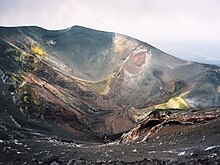

Following six years (1995–2001) of unusually intense activity at the four summit craters of Etna, the volcano produced its first flank eruption since 1991–1993 in July–August 2001. This eruption, which involved activity from seven distinct eruptive fissures mostly on the south slope of the volcano, was a mass-media eruption, because it occurred at the height of the tourist season and numerous reporters and journalists were already in Italy to cover the G8 summit in Genoa. It also occurred close to one of the tourist areas on the volcano, and thus was easily accessible. Part of the "Etna Sud" tourist area, including the arrival station of the Etna cable car, were damaged by this eruption, which otherwise was a rather modest-sized event by Etna standards.
In 2002–2003, a much larger eruption threw up a huge column of ash that could easily be seen from space and fell as far away as Libya, 600 km (370 mi) south across the Mediterranean Sea. Seismic activity in this eruption caused the eastern flanks of the volcano to slip by up to two metres, and many houses on the flanks of the volcano experienced structural damage. The eruption also completely destroyed the tourist station Piano Provenzana, on the northeastern flank of the volcano, and part of the tourist station "Etna Sud" around the Rifugio Sapienza on the south flank. Footage from the eruptions was recorded by Lucasfilm and integrated into the landscape of the planet Mustafar in the 2005 film Star Wars Episode III: Revenge of the Sith.[18] The Rifugio Sapienza is near the site of a cable car station which had previously been destroyed in the 1983 eruption; it has now been rebuilt. Following a rather silent, slow and non-destructive lava outflow on the upper southeastern flank between September 2004 and March 2005, intense eruptions occurred at the Southeast Crater in July–December 2006. These were followed by four episodes of lava fountaining, again at the Southeast Crater, on 29 March, 11 April, 29 April and 7 May 2007. Ash emissions and Strombolian explosions started from a vent on the eastern side of the Southeast Crater in mid-August 2007.
On 4 September 2007 a spectacular episode of lava fountaining occurred from the new vent on the east side of the Southeast Crater, also producing a plume of ash and scoriae which fell over the east flank of the volcano. A lava flow travelled about 4.5 km (2.8 mi) into the uninhabited Valle del Bove. This eruption was visible far into the plains of Sicily, ending the following morning between the hours of 5 to 7 am local time. Catania-Fontanarossa Airport shut down operations during the night for safety precautions.[verification needed]
An eruption on the morning of 13 May 2008, immediately to the east of Etna's summit craters was accompanied by a swarm of more than 200 earthquakes and significant ground deformation in the summit area. The eruption continued at a slowly diminishing rate for 417 days, until 6 July 2009, making this the longest flank eruption of Etna since the 1991–1993 eruption that lasted 473 days. Previous eruptions, in 2001, 2002–2003, and 2004–2005 had lasted 3 weeks, 3 months, and 6 months, respectively. Lava flows advanced 6.5 km during the first few days of this eruption but thereafter stagnated at much minor distances from the vents; during the last months of the eruption lava rarely advanced more than 1 km downslope.
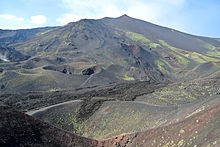
Through January 2011 to February 2012, the summit craters of Etna were the site of intense activity. Frequent eruptions and ash columns forced the authorities to shut down the Catania airport on several occasions. [19][20][21][22][23][24] The July 2011 episode also endangered the Sapienza Refuge, the main tourist hub on the volcano, but the lava flow was successfully diverted.[25] In 2014, a flank eruption started involving lava flows and strombolian eruptions. This was the first flank eruption since 2008-09[1]
Smoke rings
In the 1970s Etna erupted smoke rings,[26] one of the first captured events of this type, which are extremely rare. This happened again in 2000.[27] Video footage of the 8 June 2000 event was captured by a naturalist filmmaker Geoff Mackley.,[28][29] Another event occurred on 11 April 2013.[30]
Facilities
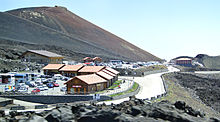
Etna is one of Sicily's main tourist attractions, with thousands of visitors every year.[31] The most common route is through the road leading to Sapienza Refuge, lying at the south of the crater at elevation of 1910 m. It hosts a large parking, several bars, a hotel, and is a starting point for the cable car.[32] From the Refuge, a cableway runs uphill to the elevation of 2500 m; from there, visitors can take a drive with special terrain vehicles, or take a long walk to the designated crater area at 2920 m.[33]
Ferrovia Circumetnea – Round-Etna railway – is a narrow-gauge railway constructed between 1889 and 1895. It runs around the volcano in a 110-km long semi-circle starting in Catania and ending in Riposto 28 km north of Catania.
There are two ski resorts on Etna: one at the Sapienza Refuge, with a chairlift and three ski lifts, and a smaller one on the north, at Piano Provenzana, with three lifts and a chairlift.[34]
See also
- List of volcanoes in Italy
- Volcanic Seven Summits
- Genista aetnensis, the Mount Etna broom
Footnotes
- ^ a b The elevation varies with volcanic activity.the volcano last erupted on the 27th of January 2014 .It is frequently given as 3,350 m (10,990 ft), but many sources that support this concede that it is approximate. The coordinates given, which are consistent with SRTM data, are from a 2005 GPS survey. The elevation data are based on a LIDAR (Light Detection and Ranging) survey carried out in June 2007, see Neri, M.; et al. (2008), "The changing face of Mount Etna's summit area documented with Lidar technology", Geophysical Research Letters, 35: L09305, Bibcode:2008GeoRL..3509305N, doi:10.1029/2008GL033740
{{citation}}: Explicit use of et al. in:|last2=(help) - ^ "Italy volcanoes and Volcanics". USGS.
- ^ Aelian, Hist. An. xi. 3, referenced under Aetnaeus in William Smith's Dictionary of Greek and Roman Biography and Mythology
- ^ "Decade Volcanoes". United States Geological Survey.
- ^ Mount Etna Becomes a World Heritage Site, Italy Magazine, 4 May 2013
- ^ "Volcano – Podictionary Word of the Day". Blog.oup.com. 2010-04-29. Retrieved 2011-06-02.
- ^ "Woodhouse's English-Greek Dictionary Page Image". Artflx.uchicago.edu. Retrieved 2011-06-02.
- ^ Chevedden, Paul E. (2010), "A Crusade from the First: The Norman Conquest of Islamic Sicily, 1060-1091", Al-Masaq: Islam and the Medieval Mediterranean, 22 (2), doi:10.1080/09503110.2010.488891
- ^ Template:It "Note di toponomastica" (PDF). Archived from the original (PDF) on 2009-03-27. Retrieved 2011-08-20.
- ^ Martin-Schutz, Alicia. "Mt. Etna".
- ^ Pareschi, M. T.; Boschi, E.; Favalli, M. (2007), "Holocene tsunamis from Mount Etna and the fate of Israeli Neolithic communities", Geophysical Research Letters, 34: L16317, Bibcode:2007GeoRL..3416317P, doi:10.1029/2007GL030717
{{citation}}: Unknown parameter|lastauthoramp=ignored (|name-list-style=suggested) (help) - ^ Attention: This template ({{cite doi}}) is deprecated. To cite the publication identified by doi:10.1007/s00445-007-0121-x, please use {{cite journal}} (if it was published in a bona fide academic journal, otherwise {{cite report}} with
|doi=10.1007/s00445-007-0121-xinstead. - ^ Aeneid, edition of Theodore C. Williams, ca. 1908 [book III, lines 569–579]
- ^ Coltelli, M.; Del Carlo, P.; Vezzoli, L. (1998), "Discovery of a Plinian basaltic eruption of Roman age at Etna Volcano, Italy", Geology, 26 (12): 1095–1098, Bibcode:1998Geo....26.1095C, doi:10.1130/0091-7613(1998)026<1095:DOAPBE>2.3.CO;2
{{citation}}: Unknown parameter|lastauthoramp=ignored (|name-list-style=suggested) (help) - ^ "Mount Etna (volcano, Italy)". (the Encyclopædia Britannica has been wrongly cited as one source of this false information).
- ^ "Etna and Man". Boris.vulcanoetna.it. Retrieved 2011-06-02.
- ^ Barberi, F.; Carapezza, M. L.; Valenza, M.; Villari, L. (1993), "The control of lava flow during the 1991–1992 eruption of Mt. Etna", Journal of Volcanology and Geothermal Research, 56 (1–2): 1–34, Bibcode:1993JVGR...56....1B, doi:10.1016/0377-0273(93)90048-V
- ^ "press_text_booklet.indd" (PDF). Retrieved 2011-06-02.
- ^ Italy's Mt Etna erupts | WORLD News
- ^ Ken Kremer (15 January 2011). "Spectacular Eruptions of Mt. Etna in Sicily from Space and Earth". Universetoday.com. Retrieved 2011-06-02.
- ^ There she blows! Stunning images of Mount Etna eruption, Mirror, 9 February 2012
- ^ Eruption of Mt. Etna closes airport in Catania, Agi.it, 23 October 2011
- ^ "INGV - Etna Observatory". Ct.ingv.it. Retrieved 2011-06-02.
- ^ "BBC News - Footage shows Mount Etna spewing lava and ash". Bbc.co.uk. 2011-05-12. Retrieved 2011-06-02.
- ^ Airport closed as Etna blows on, Daily Mail, 3 April 2013
- ^ http://www.stromboli.net/etna/etna00/etna0002photovideo-en.html Smoke rings generated by eruptions of Etna volcano
- ^ "Etna hoops it up". BBC News. 2000-03-31. Retrieved 2008-10-09.
- ^ "Erupting Mt. Etna coughs up a smoke ring". WJLA (ABC) Storm Watch 7. 2011-08-16. Retrieved 2013-04-15.
- ^ Geoff, Mackley. "Mt Etna - Sicily, Italy - the greatest show on earth !". Geoff Mackley. Retrieved 15 April 2013.
- ^ "Mount Etna blows smoke rings during volcanic eruptions". NBC News. 2013-04-12. Retrieved 2013-04-15.
- ^ Etna National Park, Italy, National Geographic Travel
- ^ Rifugio Sapienza: who we are
- ^ Funivia dell'Etna, Lonely Planet
- ^ Skiing Mount Etna: Hit the slopes one day, sail the next, Telegraph, 12 March 2010
References
- "Etna". Global Volcanism Program. Smithsonian Institution. Retrieved 2008-12-25.
- Chester, D. K.; Duncan, A. M.; Guest, J. E.; Kilburn, C. R. J. (1985). Mount Etna: The Anatomy of a Volcano. Chapman and Hall. pp. 412 pp. ISBN 0-8047-1308-1.

